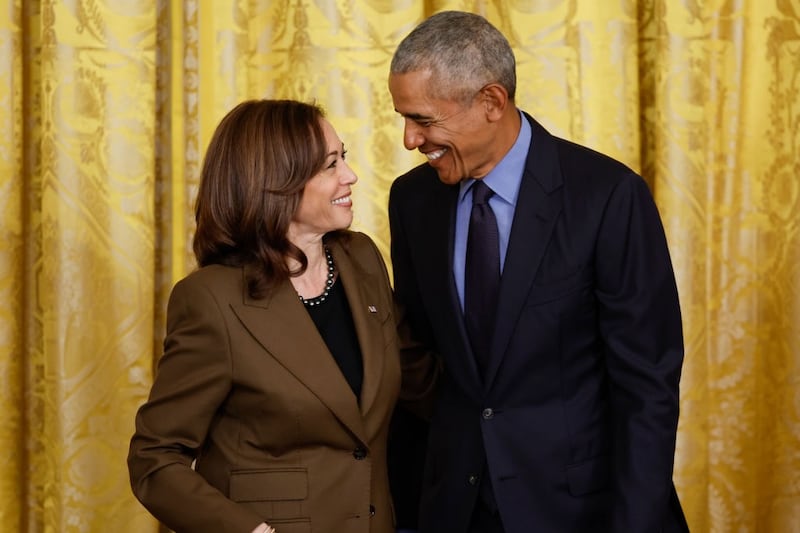
Ask and ye shall receive.
After months of a very vocal chorus of voters offering strident criticism of Vice President Kamala Harris, her campaign this week unveiled what it’s calling an Opportunity Agenda for Black Men.
Going back to her unsuccessful 2020 presidential campaign, Harris has continually met opposition from some corners of Black Male America for her work as a local prosecutor and attorney general in California, where Black men — like everywhere else in this country — are disproportionately impacted by the criminal legal system.
Not that this new plan has quieted the crowd. The nine-page document outlines how a Harris Administration would provide one million forgivable loans to small business owners, create mentorship programs, promote Black men’s health and more. But many remain dissatisfied.
Now my Twitter mentions are full of people campaignsplaining to me that the plan is meaningless because the programs aren’t specifically available to people who identify and Black and as men to the exclusion of other categories, which would be unconstitutional on its face but legalities never stopped people from being loud and wrong on the Internet.
Deconstructing the Black-voter monolith
About a month ago, I caught a video from Astead Herndon, a national politics reporter at the New York Times, breaking down a new study called the Black Values Survey. Published by three groups — Democracy & Power Innovation Fund, HIT Strategies and Sojourn Strategies — the survey includes nearly 3,000 African American respondents (about two-thirds registered voters; the other third not).
I’ve been absolutely obsessed with it ever since. As far as I can remember, it’s the most thorough breakdown of the Black electorate published in recent history. If I can go on a quick angry tangent: I’ve long been annoyed that White voters get to be segmented and analyzed by pollsters as everything from suburban soccer moms to working-class men without college degrees while voters of color are only studied as a bloc.
We’ve been saying for decades that Black and other groups of color are not monoliths; this study is one of the first I’ve seen that actually crushes that monolith.
Here’s who they are:
Legacy Civil Rights (41% of respondents)
—They are the oldest cohort, mostly members of the Baby Boomer generation
—Strong Black identity, strong Democrats
—The have the highest voting power and highest likelihood to vote
—Their top issues: Racism, healthcare, voting rights, inflation
Secular Progressives (12%)
—Mostly Gen X and millennials
—High income, most educated of the cohorts
—Strong belief in systemic racism as a barrier, low sense of collective power
—Top issues: Healthcare, racism, inflation
NextGen Traditionalists (18%)
—Mostly millennials and Gen Z
—Have a strong Black identity, high religiosity, lower income and education
—Lower voter turnout
—Top issues: Healthcare, racism, jobs, crime
Rightfully Cynical (22%)
—Youngest cohort (Gen Z, millennials)
—Low trust in Democrats and Republicans, low political efficacy
—Moderate vote power, least likely to vote
—Top issues: Inflation, healthcare, jobs
Race-Neutral Conservatives (7%)
—Mostly men, weak Black identity
—Highest Republican party identification (37%).
—Lowest vote power (4-10) and low approval of Democrats
—They have the highest incomes of the five cohorts
—Top issues: Inflation, crime, jobs
The full survey breaks the cohorts down even more, along the lines of dissatisfaction with the direction of the country, attitudes on abortion and reparations, marital status and more.
Why I find this all so fascinating is because so much attention right now is focused on Black voters, and Black men in particular, and how they’ll vote in crucial states like Pennsylvania, Michigan and Georgia.
My hope is that this more nuanced understanding of the potential Black electorate one day becomes part of mainstream political discourse.
(T)oday (I) (L)earned
Such-and-Such is not a monolith.
It’s become a cliche, but where did it start?
I tried to pinpoint its origins to a particular text, but came up short.
However, I was able to trace the evolution of the concept over time
- 1937: Herbert Tingsten’s book Political Behavior: Studies in Election Statistics is one of the earliest works in the last 100 years to discuss voting behaviors in terms of uniform patterns within demographic groups, though Tingsten does not explicitly use the term “monolith.”
- 1960: The University of Michigan’s 1948 Survey Research Center produced seminal scholarship on voting behavior, especially focusing on the homogeneity within voting blocs such as union workers or racial groups. Works like The American Voter by Campbell, Converse, Miller, and Stokes (1960) were pivotal in analyzing voting trends by demographic categories.
- Late 60s-early 70s: Early analyses of African American voting patterns after the 1965 Voting Rights Act described the group as overwhelmingly Democratic. This is reflected in political commentary from the late 1960s and 1970s, such as Robert Dahl’s work on the idea of group-based political influence. Check out Reckon’s podcast Panther for more about organizing in Alabama after the VRA was passed.
- 1990s: The idea of the “monolithic voting bloc” became more prevalent in the late 20th century, especially in political discourse describing racial, ethnic, and ideological groups. Scholars such as Michael Dawson, in his work Behind the Mule: Race and Class in African-American Politics, discuss the oversimplification of the Black electorate as a monolith. Similarly, Lani Guinier’s work The Tyranny of the Majority criticizes the reductive view of minority groups as voting blocs in American politics. Both books were published in 1994.


